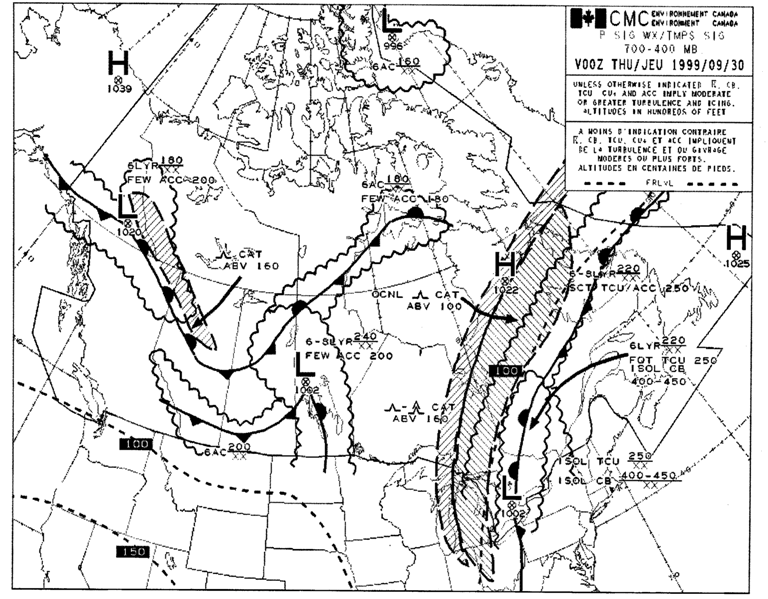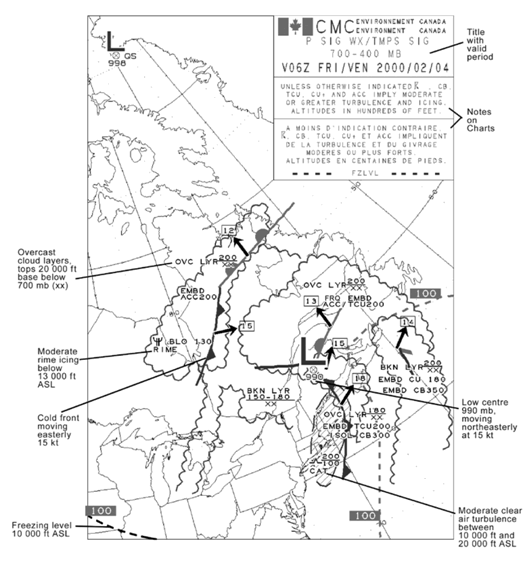WEATHER INFORMATION
- WEATHER INFORMATION
- Aviation Weather Reports (METAR)
- Type of Report
- Station identification
- Date and Time of Issue
- Wind
- Prevailing Visibility
- Runway Visual Range
- Present Weather
- Sky Opacity
- Temperature, Dew Point, Altimeter Setting Pressure
- Wind Shear
- Remarks
- Special Weather Reports (SPECI)
- AWOS
- Aerodrome Forecasts (TAF)
- Change Groups: From, Becoming, Temporary, and Probability
- Upper Winds (FD)
- Other Reports
- Weather Charts
- Prognostic Charts
- Graphic Area Forecasts (GFA)
- GFA Weather Information—CLDS & WX GFA
- Clouds
- Visibility
- Airborne Weather Radar
- Lightning Detectors
Aviation Weather Reports (METAR)
METAR (Aviation Routine Weather Report) are the most common weather reports used by pilots. The following is a typical example of the METAR format:
METAR CYYC 071500Z 04010KT 11/2SM -RAFGFU FEW003 OVC007 05/04 A2983 RMK SF2 ST6 VIS 1 SW SLP 115
A METAR is a description of weather conditions at a particular place and particular time. They are prepared hourly, or whenever there is a significant weather change, by Environment Canada or Flight Service personnel at specified airports (listed in the AIM).
Type of Report
METAR CYYC 071500Z 04010KT 11/2SM -RAFGFU FEW003 OVC007 05/04 A2983 RMK SF2 ST6 VIS 1 SW SLP 115
Although the METARs are most commonly used, there are actually three categories of aviation weather reports: METAR, SPECI, and METAR CCA.
The header “METAR” indicates a regular observation, completed hourly.
With a significant change in weather, a “SPECI” will be released anytime (see below).
If a METAR requires a correction, the expression “CCA” indicates the first correction (“CCB” indicates the second correction, if necessary), and this notation appears behind the date and time of observation.
Station identification
METAR CYYC 071500Z 04010KT 11/2SM -RAFGFU FEW003 OVC007 05/04 A2983 RMK SF2 ST6 VIS 1 SW SLP 115
|
Y or Z |
Reporting station co-located with an airport. |
|
W |
Reporting station not co-located with an airport. |
|
U |
Reporting station co-located with a radio beacon. |
In METARs the identification—e.g., CYYC indicating Calgary International Airport—always consists of four letters.
The first letter “C” indicates Canadian, while the second letter designates the type of weather reporting station, with variations of this shown on the right
The last two letters identify the airport—e.g., VR (Vancouver), YC (Calgary), EG (Edmonton), or WG (Winnipeg). Airport identifications are published in the Canadian Flight Supplement.
Date and Time of Issue
METAR CYYC 071500Z 04010KT 11/2SM -RAFGFU FEW003 OVC007 05/04 A2983 RMK SF2 ST6 VIS 1 SW SLP 115
This is rather straight forward, and incidentally a common date/time format used in aviation information: this METAR was issued on the 7th day of the month (month not specified), at 1500Z.
Wind
METAR CYYC 071500Z 04010KT 11/2SM -RAFGFU FEW003 OVC007 05/04 A2983 RMK SF2 ST6 VIS 1 SW SLP 115
Winds are reported with the first three numbers indicating the direction (rounded to the nearest 10°), while the last two numbers indicate speed; therefore, in this example the wind is 040° at 10 KTS.
Calm winds are indicated by “00000KT.” Gusty winds are indicated by “G”—24015G20KT—where the winds are 15 KTS gusting to 20 KTS. Where the winds are light and variable, the abbreviation VRB appears—220VRB. If variable winds during the ten minutes before the observation varied more than 60° and the mean (average) speed exceeded 3 KTS, the wind is reported as follows: 030V140.
Remember that wind direction is indicated in degrees TRUE, not magnetic (remember, the only time wind direction is given as magnetic is when provided by the tower during landings and takeoffs). Wind speed is always in KTS.
Prevailing Visibility
METAR CYYC 071500Z 04010KT 11/2SM -RAFGFU FEW003 OVC007 05/04 A2983 RMK SF2 ST6 VIS 1 SW SLP 115
Remember, visibility is always given in statute miles (not nautical) and it appears after wind information. In this case the visibility is 1-½ statute miles.
Runway Visual Range
METAR CYYC 071500Z 04010KT 1SM RW34/5000FT/D -RAFGFU FEW003 OVC007 05/04 A2983 RMK SF2 ST6 VIS 1 SW SLP 115
Runway Visual Range (RVR) is used for IFR operations when the prevailing visibility is well below VFR limits.
Present Weather
METAR CYYC 071500Z 04010KT 11/2SM -RAFGFU FEW003 OVC007 05/04 A2983 RMK SF2 ST6 VIS 1 SW SLP 115
This is an important section and you want to be familiar with the format and codes used here; in this example they are calling the weather light rain, with fog and smoke.
This section describes any weather phenomena existent at the airport, specifically noting precipitation, sky obscuration, or any other weather phenomena.
Qualifiers
|
Qualifiers |
Intensity or Proximity |
|---|---|
|
- |
Light |
|
(no sign) |
Moderate |
|
+ |
Heavy |
|
VC |
In the Vicinity |
“Qualifiers” precede the weather phenomena description, which denote the intensity or proximity of the phenomena. The format and codes used are indicated to the right.
If the intensity of reported phenomena is light or heavy, the appropriate sign is used; if the intensity is moderate, or when the intensity is not relevant to the phenomena (e.g., volcanic ash or a funnel cloud), no sign is included.
Where more than one precipitation phenomena is reported, the predominant type of precipitation is reported first, but the intensity grade only represents the “overall” intensity of the combined precipitation types.
The code “VC” (in the vicinity) is used if the phenomena are located within 5 miles of the airport, but not at the airport itself.
Descriptors
|
Descriptors |
|||
|---|---|---|---|
|
SH |
showers |
MI |
shallow |
|
FZ |
freezing |
BC |
patches |
|
BL |
blowing |
TS |
thunderstorms |
|
DR |
drifting |
PR |
covering part of airport |
In contrast to the qualifiers (which are really, for the most part, intensity), the “descriptors” describe the form the weather is taking. The associated codes appear to the right.
Weather Phenomena
Now we get to the bones of the METAR that really is the weather at hand, and these too will have to be memorized:
|
Precipitation |
Obscuring Phenomena |
Other |
|||||||||
|---|---|---|---|---|---|---|---|---|---|---|---|
|
RA |
rain |
HZ |
haze |
SQ |
squall |
||||||
|
SN |
snow |
FU |
smoke |
DS |
dust storm |
||||||
|
DZ |
drizzle |
SA |
sand |
SS |
sand storm |
||||||
|
PL |
ice pellets |
DU |
dust |
VA |
volcanic ash |
||||||
|
SG |
snow grains |
FG |
fog |
PO |
dust and whirls |
||||||
|
IC |
ice crystals |
BR |
mist |
FC |
funnel cloud |
||||||
|
GR |
hail |
|
|
+FC |
Tornado/waterspout |
||||||
|
GS |
snow pellets |
|
|
|
|
||||||
|
UP |
Unknown (AWOS) |
|
|
|
|
||||||
The descriptors of “MI” (shallow), “BC” (patches) and “PR” (partial) are used only in combination with fog (“FG”)— e.g., “BCFG.” Similarly, “DR” (drifting) and “BL” (blowing) are only used in association with “SN” (snow), “SA” (sand), or “DU” (dust).
If “BLSN” (blowing snow) and “SN” (snow) occur simultaneously, they are both reported, but in distinct present weather groups—e.g., “SN BLSN.”
The code “SH” (showers) is only used in association with precipitation types—i.e., “RA” (rain), “SN” (snow), “PL” (ice pellets), “GR” (hail), and “GS” (snow pellets) if they occur at the time the observation is made—e.g., “–SHSNGS.”
The code “TS” (thunderstorm) is reported alone or in combination with one or more precipitation types. The thunderstorm is considered to have ended if thunder has not been heard within the last 15 minutes. Note that “TS” and “SH” cannot appear together since present weather groups can only have one descriptor.
Finally, note that “FZ” (freezing) can be used only in association with a precipitation type—”DZ” (drizzle), “RA” (rain), and “FG” (fog).
Where the reported weather phenomena is precipitation of different kinds, these are combined to form one group; the only exception to this is “FZ” (freezing precipitation) which is always reported as a separate present weather group (e.g., FZRA or FZDZ).
Any obstructions to vision (obscuration) are reported when the prevailing visibility is 6 SM or less. If the obscuration occurs simultaneously with one or more types of precipitation, the obscuration type is reported as a separate present weather group. Note that both BR and FG refer to fog; BR is used when the visibility is greater or equal to 5/8 SM, while FG is used when visibility is less than 5/8 SM.
“Other phenomena” are reported in separate groups, and codes for funnel clouds, tornadoes or waterspouts are repeated in the remarks section where they are written out in full (e.g., RMK TORNADOS).
Sky Opacity
METAR CYYC 071500Z 04010KT 11/2SM -RAFGFU FEW003 OVC007 05/04 A2983 RMK SF2 ST6 VIS 1 SW SLP 115
This group describes the sky condition with respect to cloud layers aloft. Heights are reported in hundreds, and cloud opacity (i.e., the amount of visible sky observed through a layer) is reported in eighths (e.g., 2/8), known as “oktas” (see right).
|
Cloud Height (AGL) |
Opacity at Layer |
||||||
|---|---|---|---|---|---|---|---|
|
005 |
500’ |
SKC |
clear |
||||
|
050 |
5000’ |
FEW |
few (1/8 to 2/8) |
||||
|
500 |
50000’ |
SCT |
scattered (3/8 to 4/8) |
||||
|
|
|
BKN |
broken (5/8 to 7/8) |
||||
|
|
|
OVC |
overcast (8/8) |
||||
Note that the cloud opacity reported is in fact a “summation amount” for the cloud layers observed from the surface. Accordingly, if two scattered layers are observed, each composed of 3/8th cloud, the second layer actually described as “broken” (3/8+3/8=6/8).
If the sky is obscured by a phenomenon such as precipitation, “vertical visibility” is reported instead of cloud opacity, indicated by the code “VV.” Vertical visibility is reported in hundreds of feet.
Note: -BKN (thin broken) and OVC (thin overcast) do not constitute ceilings for the purpose of restricting VFR flight. Instead, a “cloud ceiling” is said to exist at the height at which the first layer is described as “BKN” or “OVC.”
Where significant convective clouds exist—i.e., a cumulonimbus or towering cumulus—these are identified by the codes CB or TCU, and are attached to the cloud group without a space (e.g., SCT025TCU).
Temperature, Dew Point, Altimeter Setting Pressure
METAR CYYC 071500Z 04010KT 11/2SM -RAFGFU FEW003 OVC007 05/04 A2983 RMK SF2 ST6 VIS 1 SW SLP 115
Temperature and dew point are rounded off to the nearest whole number, and negative temperatures are preceded by the letter M.
A2992 equals 29.92 “Hg.
Wind Shear
There is no wind shear in this example; nevertheless, it will appear when a wind shear is reported within 1600’ AGL on the departure or approach end of runways, the runway numbers will be identified following the indicator WS.
Remarks
METAR CYYC 071500Z 04010KT 11/2SM -RAFGFU FEW003 OVC007 05/04 A2983 RMK SF2 ST6 VIS 1 SW SLP 115
Remarks will appear at the end of the sequence, prefaced by RMK. The remarks will, where observed, contain the cloud layer type and degree of opacity of sky covered by the layers in oktas, each layer described corresponding to the sequence contained in the “sky condition” depicted earlier in the report. See the examples below.
|
CI7 |
Cirrus covering 7/8 of the sky |
|---|---|
|
NS2 |
Nimbostratus covering 2/8 of the sky |
|
SF6 |
Strato fractus covering 6/8 of the sky |
|
CB4 |
Cumulonimbus covering 4/8 of the sky |
Additional cloud types are abbreviated as follows: CS - cirrostratus; CC - cirrocumulus; AS - altostratus; AC - altocumulus; ST - stratus; SC - stratocumulus; ACC - altocumulus castellanus; CU - cumulus; CF - cumulus fractus; TCU - towering cumulus.
|
263 |
represents |
1026.3 hPa |
|
983 |
represents |
998.3 hPa |
Sea Level Pressure, reported in hectopascals (hPa) is reported at the end of the data, behind letters SLP. It may be noted that the initial “9” or “10” is omitted because sea level pressure varies only between 960.0 millibars and 1050.0 hPa (this need not be memorized).
Special Weather Reports (SPECI)
SPECI appear for reporting stations whenever there is a significant change in the weather that occurs between scheduled hourly transmissions. In particular, a SPECI will be issued if any of the following occur:
- the ceiling decreases to 1500’ or less, or when a cloud layer, previously not reported, appears below 1000’ (or below the highest minimum for straight-in IFR landings, or the minimum for IFR departures);
- visibility decreases to below 3 SM;
- a tornado, waterspout or funnel cloud is reported;
- a thunderstorm begins, intensifies to “heavy,” or ends;
- precipitation begins, changes, or ends;
- winds suddenly increase and exceed 30 KTS (speed must double), or when the direction of the winds significantly changes (satisfying the criteria for “wind shift” (see “wind” above).
AWOS
There are three types of automatic weather station reporting systems, identified as AWOS 1, 2, and 3. AWOS 1 reports wind, altimeter setting, temperature, and dew point. AWOS 2 has visibility, and AWOS 3 has cloud layers.
Formats for AWOS reports are somewhat different from that of METAR reports, and for this reason, FSS should be consulted for interpretation (see AIM MET 3.15.2).
Aerodrome Forecasts (TAF)
|
12 hours |
24 hours |
|---|---|
|
06Z – 18Z |
06Z – 06Z |
|
12Z – 24Z |
12Z – 12Z |
|
18Z – 06Z |
18Z – 18Z |
|
24Z – 12Z |
24Z – 24Z |
TAFs describe the weather conditions that will affect landings and takeoffs at specified aerodromes.
Importantly, heights of clouds are always reported above ground, and the area to which a TAF applies is limited to within5 NM of the aerodrome.
TAFs are issued usually one-half hour before the coverage period, and the coverage period can be 12 or 24 hours (depending on the size of the airport, see the AIM, MET 3.8). The coverage periods are indicated to the right.
The coverage period for a TAF appears in the first part, for example, as follows:
TAF CYQL 091730 0918/1006 . . .
TAF CYYZ 091730 0918/1018 . . .
The first TAF is valid for Lethbridge Airport (CYQL is the identifier, as depicted in the Canada Flight Supplement), and the second is valid for Toronto (CYYZ). The first set of numbers in the TAF (i.e., 091730) indicate the date and time at which the TAF was issued, where “09” indicates the 9th day, and “1730” indicates the time of issue (1730Z). All dates and times are depicted in Universal Co-ordinated Time (UTC or Zulu time). The second set of numbers (0918/1006 or 0918/1018) reports the day and time of the beginning of the coverage period (the 9th day of the month, both beginning at 1800Z and the subsequent times at which coverage ends. It is implied, therefore, that the Lethbridge TAF is a 12-hour forecast valid from 1800Z on the 9th day of the month to 0600Z on the 10th day. The Toronto TAF is valid for 24 hours, ending at 1800Z on the 10th day.
With respect to the content of TAFs, consider the following example:
TAF CYXX 291145Z 2912/3012 24010G25KT WS011/27050KT 3SM -SN BKN010 OVC040 TEMPO 2918/2901 11/2SM -SN BLSN BKN008 PROB30 2920/2922 1/2SM SNVV005 FM300130Z 28010KT 5SM -SN BKN020 BECMG 3006/3008 00000KT P6SM SKC RMK NXT FCST BY 291800Z
The identifier, issue date/time, and validity period are as described above, and note that all the date and time references specified either the 29th day or the 30th day.
The surface wind is forecast to be 240° true (be careful of this as forecast winds are always reported in degrees true).
Low level wind shear (WS) is forecast to exist from the surface up to 1100’ AGL, with the wind at that height expected to be 270° true at 50 KTS (obviously the appearance of this wind shear information would be as rare as the phenomenon itself). Wind shear is reported whenever a shear is expected below 1500’ AGL.
The forecast prevailing visibility in this example is 3 SM, owing to light snow (-SN). In the case that the visibility is expected to be greater than 6 SM, it is reported as “P6SM” with “P” meaning “plus.”
The clouds forecast are a broken layer at 1000’ AGL, and an overcast layer at 4000 AGL. If cumulonimbus (CB) is expected, this will appear following the layer (e.g., SCT020CB).
Change Groups: From, Becoming, Temporary, and Probability
TEMPO means a “temporary change” in forecast conditions, in this case between 1800Z on the 29th day and 0100Z on the 29th day (indicated by 2918/2901), where the conditions will change to 1 and 1/2 SM visibility, owing to light snow and moderate blowing snow, accompanied by a broken layer based at 800’ AGL.
As a rule, whenever a “change group” is depicted, whether it apears as FM for “from,” BECMG for “becoming,” TEMPO for “temporary,” or PROB for “probability,” the specified weather elements described in the change group (whether it be precipitation, visibility, or cloud layers) replace the equivalent weather elements that existed previously to the change. For example, “FEW030 BKN050 OVC080 . . . [change group type] . . . BKN050” implies that the three cloud layers predicted prior to the change will no longer exist, with only the one broken layer existing at 5000’.
Here are the criteria associated with the different change group types:
|
FM220130Z |
FM appears whenever a permanent change to the forecast weather is expected to occur rapidly. All forecast conditions that previously occurred are replaced or superseded. Accordingly, all forecast weather elements will appear after this code, including the conditions unaffected by the change. The time at which the rapid change is forecast to occur is also depicted, in this case 0130Z on the 22nd day (day, hours and minutes). There is a slight complication with the FM code: if there are additional changes within the hour following the time depicted, those additional changes make reference using “whole hours.” This is best explained by an example: let us assume that “FM280915Z” appears; if there was a subsequent temporary change, say forecast to begin shortly after 0915Z on the 28th day, those changes would be depicted as “TEMPO 2809/2811” (lasting from 09Z on the 28th day to 11Z on the 28th day), when in actuality they are expected between 0915Z and 1100Z on the 28th day. |
|---|---|
|
BECMG 2206/2208 |
This indicates a permanent but gradual change in conditions expected to evolve over a period of time (normally one to two hours, but never more than four hours)—in this case from 0600Z on the 22nd day to 0800Z on the 22nd day. Any weather element that is not indicated as part of the BECMG conditions remains the same as depicted in the period preceding. If the change entails significant weather, however, all of the weather-associated elements will be included even though they are unchanged; the code NSW is used when significant weather is forecast to end. The use of this change group is kept to a minimum (owing to its complexity, thank goodness!), and is only used in those cases where only one or two weather groups are expected to change while all others remain the same; when more than two weather groups are forecast to change, the depiction “FM” will be used to start a new self-contained weather sequence. |
|
TEMPO 2218/2301 |
This indicates that the change group is a temporary fluctuation in conditions, occurring in the period indicated (1800Z on the 22nd day to 0100Z on the 23rd day). Like BECMG, any weather element that is not indicated as part of the TEMPO conditions remains the same as depicted in the period preceding. Similarly, if the change entails significant weather, however, all of the weather-associated weather elements will be included even though they are unchanged; and the code NSW is used when significant weather is forecast to end. As a rule, TEMPO is used when the forecast is changed for periods of less than one hour in duration and when the total of duration periods is not more than one-half the forecast period in which the modified conditions are expected to occur. If the conditions are expected during more than one-half of the forecast period, then FM or BECMG will be used |
|
PROB30 2223/2301 |
This is the “probability” group. It provides a probability of the conditions associated with the change group—in this case 30%—and it appears whenever a condition hazardous to aviation is expected (i.e., thunderstorms, freezing precipitation, wind shear below 1500’ AGL, or ceiling less than minimum IFR operating minima). If the probability is 50% or higher, the depiction BECMG, TEMPO, or FM will be used. In the example used, the hazardous condition will exist from 2300Z on the 22nd day to 0100Z on the 23rd day. |
Accordingly, the example TAF shown on the previous page (i.e., PROB30 2920/2922 1/2SM SNVV005) provides that there is a 30% probability of visibility dropping to ½ SM in snow, with a vertical visibility of 500’ AGL, and this change is expected between 2000Z and 2200Z on the 29th day.
The above TAF example ends as follows:
FM300130Z 28010KT 5SM -SN BKN020 BECMG 3006/3008 00000KT P6SM SKC RMK NXT FCST BY 291800Z
The interpretation is as follows: after 0130Z on the 30th day, the winds are expected to drop to 280° true at 10 KTS, with 5 SM visibility in light snow, and this will be associated with a 2000’ broken layer. Finally, a gradual change is expected between 0600Z and 0800Z whereby the winds will be calm, the visibility will be greater than 6 SM, and the skies will be clear.
Upper Winds (FD)
FDs are forecast winds aloft used for navigation calculations; they are reported in the nearest 10° TRUE and include temperature. They are given in feet sea level altitudes in 3000’ spacing.
FDCN1 CWAO 071530Z
DATA BASED ON 1200Z
VALID 08000Z FOR USE 2100-0600Z
| 3000 | 6000 | 9000 | 12000 | 18000 | |
|---|---|---|---|---|---|
| YVR | 9900 | 2415-07 | 2430-10 | 2534-10 | 2542-26 |
| YYF | 2523 | 2432-04 | 2338-08 | 2342-13 | 2448-24 |
| YXC | 2431-02 | 2330-06 | 2344-11 | 2352-22 | |
| YYC | 2426-03 | 2435-06 | 2430-12 | 2342-22 | |
| YQL | 2527-01 | 2437-05 | 2442-10 | 2450-21 |
Winds are not forecast if within 1500’ of the station elevation and temperatures are not included for the 3000’ level, or for levels within 1500’ of the station elevation.
If the winds are less than 5 KTS, the code 9900 is written, which reads “light and variable.”
If the wind speeds are between 100 and 199 KTS, 50 is added to the direction and 100 is subtracted from the speed.
If the winds are greater than 199 KTS, the wind is coded as 99 KTS, and again 50 is added to the direction.
Some examples of these variations are as follows:
| 9900 + 00 | Winds light and variable, temperature 0° C. |
| 2423 | Winds 250° T at 23 KTS. |
| 791159 | Winds 290° T (79-50=29) at 111 KTS (11+100=111), temperature -59°C.1 |
| 859950 | Winds 350° T (85-50=35) at 199 KTS or more |
A list of upper winds locations is listed on AIM MET 3.10.
References
1 The minus sign (-) is not included in upper winds forecast above FL240.
Other Reports
A PIREP is a weather observation reported by a pilot; the information usually included in a PIREP is time of the report, location, aircraft type, and altitude, in addition to the weather-related observations.
An AIRMET is provided as separate weather information when potentially hazardous weather conditions were not included in the GFAs.
A SIGMET is provided as short-term warning of certain potentially hazardous weather phenomena, such as thunderstorms, heavy hail, severe turbulence or icing, mountain waves, hurricanes, etc., and are issued as a letter and number code. Validity periods are similar to other reports, with the day preceding the times.
Radar Reports (SD) are also available, providing precipitation and convection information.
Weather Charts
With respect to weather charts, there are five primary forms—Surface Analysis Charts, Upper Level Analysis Charts, Prognostic Chart Prognostic Charts, Significant Weather Chart , and Graphic Forecast Area Charts.
Surface Analysis Charts
Surface Analysis Charts represent current atmospheric conditions from the surface up to 3000’,1 and consist primarily of isobars, high and low pressure mapping, frontal depictions, and station models. They are issued four times per day at six-hour intervals, but it must be kept in mind that several hours transpire between the time that the observations were made, and the actual time the Surface Analysis Chart summarizing the weather is released and distributed.2 The time at which observations used to make the chart were made is shown in a title box on the corner of the chart.
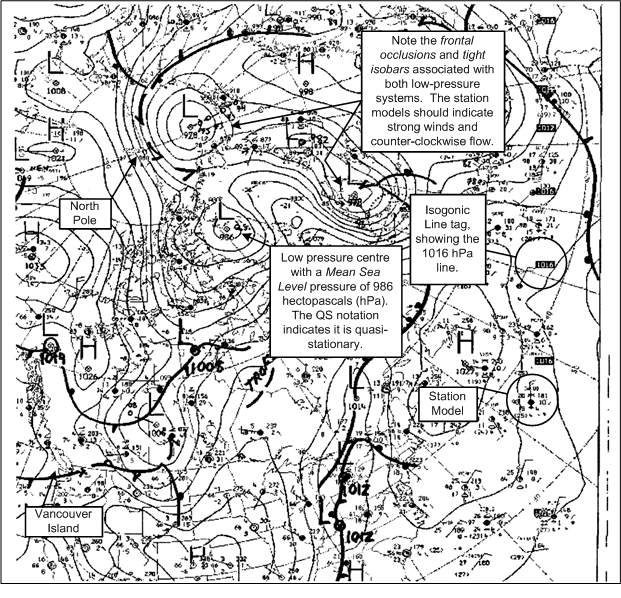
The Surface Analysis Chart above is typically of the quality of these charts provided by FSS.3 Their poor technical quality limits their utility, but basic features—isogonic patterns, pressure systems, and frontal systems—are apparent. This particular chart stretches from the North Pole at the top, to the central U.S. at the bottom. The strongest surface winds on this chart are located where the isobars form the tightest pattern, and as can be seen, two tight patterns appear in association with two low-pressure systems up north. Both of these pressure systems, in turn, display classic frontal patterns, including warm fronts, cold fronts, and occlusions.
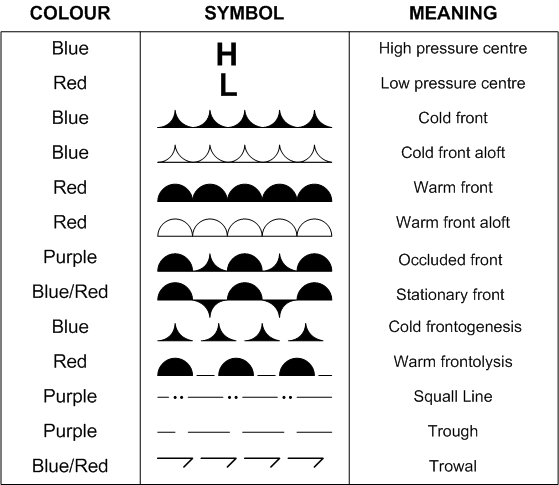
Above are the various symbols that appear on Surface Analysis Charts.4 Note the colour patterns (red/warm and blue/cold), which unfortunately cannot be reproduced here. Note also the appearance of purple in association with squall lines and troughs. It is useful to be aware of the basic design in the pattern of these symbols.5
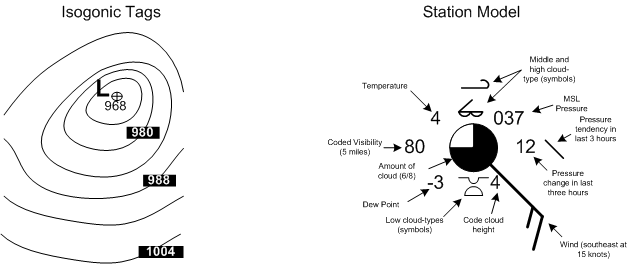
Above is a sample station model similar to what appears on Surface Analysis Charts. The prominent features include wind direction and speed, temperature, and dew point, and you want to be familiar with these. Above is also a typical depiction the mapping of a low pressure system on a Surface Analysis Chart, including the format for the tags attached to the isogonic lines. Note the low pressure bottoms out at 968 hectopascals (hPa). The depiction of pressure on a surface chart is based on measurements that occur at the surface, and this is quite different from pressure deptictions on upper air charts, where the pressure is mapped out by the height of specific pressure levels.
There is a useful depiction of a Surface Analysis Chart in the back of From the Ground Up.
References
1 Including any weather that is visible from the surface.
2 The delay in the published time of Surface Analysis Charts is frequently the source of misinterpretation on Transport Canada examinations—candidates are presented with a chart showing frontal systems and their position relative to vicinity airports on the chart, but in fact the position of the weather systems is already six hours old. If the candidate doesn’t realize this, all weather analysis using the chart will be incorrect.
3 Better quality Surface Analysis Charts are available from the Environment Canada website.
4 Derived from AIR MET 3.19.
5 One of the challenges is to be able to memorize these symbols, and there are some basic patterns in their design that may be useful for recall. Note, for example, that surface frontal systems are depicted using solid or filled symbols, while frontal systems that are suspended aloft—upper fronts—are presented as empty or unfilled symbols. This does not apply to occlusions (which are suspended above the surface as well), but they have their own unique pattern, with alternating warm front/cold front symbols that are aligned in opposing direction. The depiction of an occlusion should not be confused with the stationary front symbol where the warm/front/cold front symbols are aligned in the same direction. The squall depiction is easy if you think of a front (which is the line), and the appearance of heavy rain showers along the front (which is the double-dots). The trowel appears as a wedge, which can be thought of as the wedge of warm air suspended aloft.
Upper Level Analysis Charts
|
Hectopascals6 (hPa) |
Approximate Altitude (ASL) |
|---|---|
|
850 |
5000’ |
|
700 |
10000’ |
|
500 |
18000’ |
|
250 |
34000’ |
Upper Level Charts are similar to weather charts, except that they depict current conditions at upper levels. That have a unique feature, however, in that they are published for constant-pressure levels, and therefore appear as contours of the troposphere, with higher pressure charts depicting the weather in the lower portions of the troposphere, and lower pressure charts depicting weather in the upper troposphere. The pressure levels correspond roughly with altitudes depicted to the right, so that—for example—if you are planning a flight at FL180, you would extract weather information from the 500 hPa chart. If you think about it, the concept of pressure-level charts makes sense as aircraft at and above FL180 are actually flying constant-pressure altitudes—the altimeters are of course set to 29.92”Hg, and aircraft are in fact climbing and descending as the constant pressure levels are climbing and descending.
The primary value of Upper Level Charts is that they provide insight into the “magnitude” or “intensity” of weather systems—it could be determined from examining these charts, for example, whether a line of thunderstorms associated with a front is penetrating into the upper atmosphere.
Importantly, then, the solid lines depicted on an Upper Level Chart7 are not isobars—instead they are referred to as contour lines. The contour lines are labelled in decametres—that is, a unit of 10 metres—and thus show the height of a pressure level.8
A second important feature of Upper Level Charts is the depiction of temperature—by way of isotherms. Isotherms appear as dashed lines labelled in five-degree increments, and they only appear on the 850 and 700 hPa Charts.
An Upper Level Chart appears below. It shows the 850 hPa level at 00Z on September 29th. Note the labelling of contour lines on the left side of the map, spaced in 60 metre units, and the labelling of the isotherms (°C) on the right of the map. The contour line labelled “150” just off the B.C. Coast means that, along that line, the 850 hPa pressure line is at a height of 1500 metres—or approximately 4920’ ASL. The isotherms are spaced in 5°C increments—the isotherm located in the Atlantic Ocean off the northern U.S. seaboard is labelled “10” for 10°C, and implies that the temperature for the 850 hPa pressure level —approximately 5000’ ASL—in areas joined by this isotherm is 10°C.
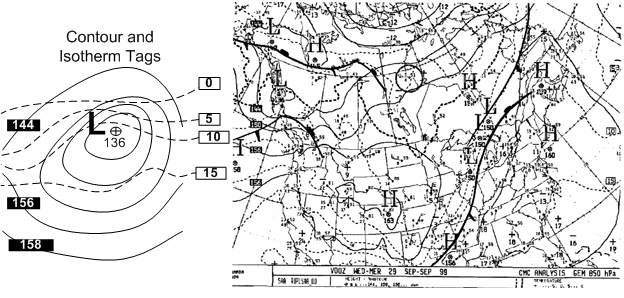
References
6 A hectopascal is equal to one millibar—the latter being the term used prior to metric conversion in Canada. 1013.2 hectopascals are equal to 29.92”Hg. To make it even more interesting, public weather uses the unit kilopascals (kPa) which equals 10 hectopascals.
7 Referred to as “ANAL Charts.”
8 The contour lines are spaced 60 meters apart on the 850, 700, and 500 hPa charts, and 120 metres apart on the 250 hPa charts.
Prognostic Charts
Perhaps the charts with the greatest value are the Prognostic Charts,9 which depict what the weather will be at a specified point in the future.
Their value to the pilot is that you can physically see future weather within a specific region.
There are three types of prognostic charts: surface prognostic charts, upper level prognostic charts, and significant weather prognostic charts.
Surface prognostic charts are issued 48 hours in advance of the predicted period and are updated every 12 hours; they depict future atmospheric conditions from the ground up to 3000’, and especially focus on the pressure pattern and frontal positions that can be expected in the surface at a specific time in the future.
Upper level prognostic charts are prepared for three levels—FL240 (Flight Level 24000), FL340, and FL450—and are issued four times a day, 12 hours in advance of the predicted period. Upper level charts depict the winds and temperature that are forecast for the specific pressure levels.
Significant weather prognostic charts are maps which depict specific future weather conditions that are of concern to aircraft—i.e., icing, mountain waves, cloud layers, thunderstorms, jet streams, and turbulence; they are prepared four times daily, 12 hours in advance of the predicted period. Two layers are depicted: low level, from FL100 to FL250, and upper level, from FL250 to FL600.
Below is an example of prognostic chart depiction. This Chart depicts significant weather at the 700 to 400 hPa pressure levels10 or approximately FL100 to FL250. Note the severe turbulence11 over Ontario. The freezing level is at 10000’ just south of B.C., and rises to 15000’ on the northern border of California. Note also the use of the codes for “ISOL,” “OCNL,” and “FQT”—which in reference to CBs implies “individual,” “well-separated,” and “little or no separation,” respectively.12
References
9 Especially the Significant Weather Prognostic Chart.
10 Referred to as millibars.
11 “CAT” or clear air turbulence; note the use of the hatched line to mark the borders.
12 See AIM MET 3.13.
The following (extracted from the AIM) shows the symbols, etc., used on Significant Weather Prognostic Charts.13 There are some items to draw your attention to: First, note how the 0°C isotherm is depicted by a dotted line and is tagged in a three digit number that represents “hundreds of feet.” Note also the format to depict cloud formations, including the appearance of “ocktas” before the cloud code, and the meaning of “XX””—the cloud base is below the chart level. Pay particular attention to the small print in the chart title box, which, by implication, always ties the thunderstorm and “CB” symbols with “moderate or greater turbulence and icing.”
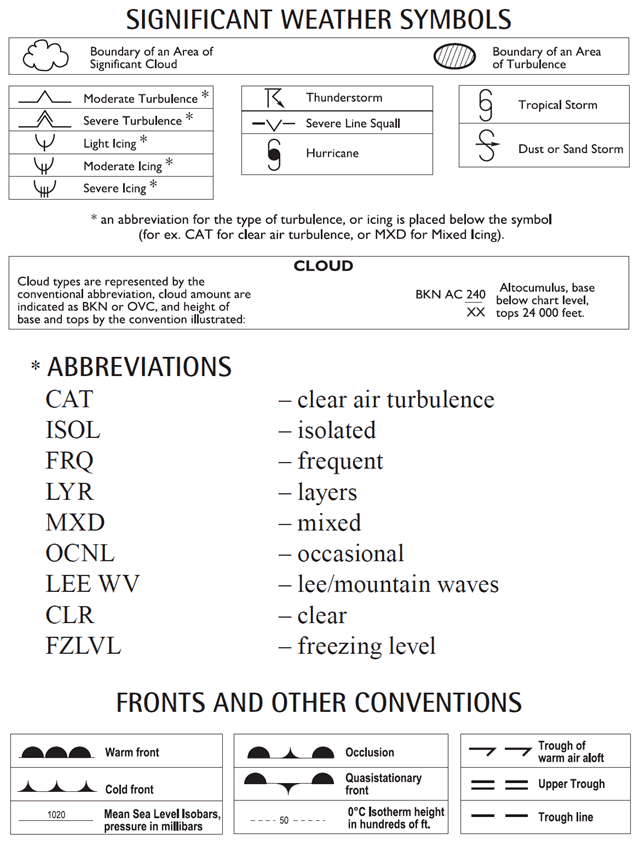
13 Derived from AIM MET 3.14.
Graphic Area Forecasts (GFA)
GFAs provide a graphic depiction of the most probable weather conditions over a specified region at a specific time. The regions, referred to as “domains” are depicted as follows:
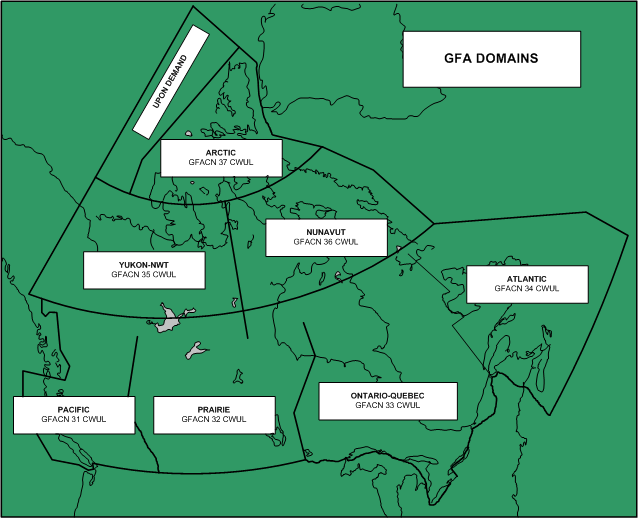
Information provided on GFAs pertains only to weather conditions below FL240 (24000’ ASL).
GFAs are issued every six hours, with the validity period of each issue beginning at the “top” and “bottom” of the Zulu (UTC) clock—0000Z, 0600Z, 1200Z, and 1800Z.
Since they are issued ½ hour before the validity time, newly published GFAs are available for use at 1130Z, 0530Z, 1130Z, and 1730Z.
Each issue of the GFA, in fact, consists of six charts, and the six charts, in turn, consist of three pairs, with each pair made up of one Clouds and Weather—abbreviated as CLDS & WX—and one Icing, Turbulence, and Freezing Level chart—abbreviated as ICG/TURBC/FRLVL.
The three paired charts that made up a GFA issue become valid—i.e., represent an accurate picture of the forecasted weather conditions—at three different times following the time of issue. The first pair provide a near-term forecast, and for this reason, this pair is referred to as the—you guessed it—the Near-term Forecast. If, for example, the GFA was issued at 2330Z, this first pair—the Near-term Forecast—would depict the expected weather at 2400Z. The second pair of charts—referred to as the Six-hour Forecast will in turn depict the weather conditions expected to exist 6-hours into the forecast period—in this case, for example, they will show the conditions expected at 0600Z—to be valid six hours after the start of the GFA issue valid time. The third and final pair of charts—referred to as the Twelve-hour Forecast—will then depict the weather conditions expected to exist 12-hours into the forecast period—in the case we have been using, for example, (with a GFA issued at 2330Z and first becoming valid at 2400Z), this final pair will depict the weather expected at 1200Z.
A final note on the Twelve-hour Forecast charts is that they contain what is referred to as an “IFR outlook” section, which summarizes conditions expected during the subsequent 12 hours following the validity start-time of the Twelve-hour Forecasts charts—in this case from 1200Z to 2400Z. So you can see that the trick in using GFAs is sorting out the validity period of three paired charts that make up an issue. Perhaps the following layout might help:
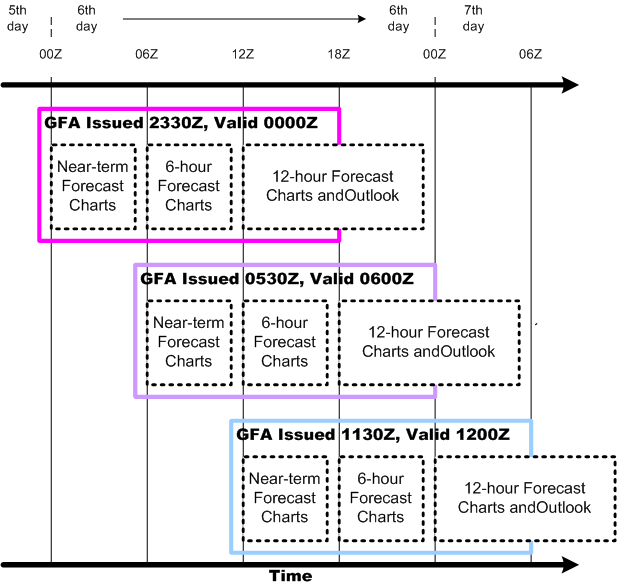
In is interesting to note here that, at any of the six-hour blocks, there will be three different sets of GFA that provide what appears as a valid forecast for the time indicated—essentially the top and bottom of the Zulu Clock (0000Z, 0600Z, 1200Z, etc.); however, only the latest issue is, of course, the most accurate forecast, and a pilot should make effort to get this latest issue for flight-planning purposes.
General GFA Format
Each of the six GFA charts has the same format—the Weather Information Section (the graphic depiction itself), a Title Box, a Legend Box, and a Comments Box:
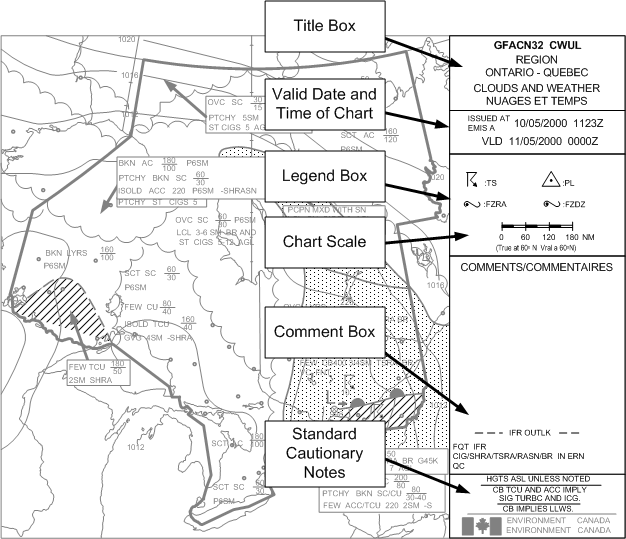

The title box indicates the issuing weather office, the GFA region for which the chart applies, the type of GFA chart (whether CLDS & WX or ICG/TURBC/FRLVL), the date and time of issue, and the validity date and time of the chart. Being able to identify the validity time of GFA, as we have said, is critical, so you want to be sure you get the reading of information in this box correct—separate the time and date of issue, on the one hand, from the time and date of validity, on the other hand. Once the validity time is sorted out, you can determine whether the GFA is Near-term, the Six-hour, or the Twelve-hour Forecast.

The legend box includes the basic weather symbols used, but also provides a scale bar depicting nautical miles—this scale bar used in determining the relative position of weather systems after the valid time.1
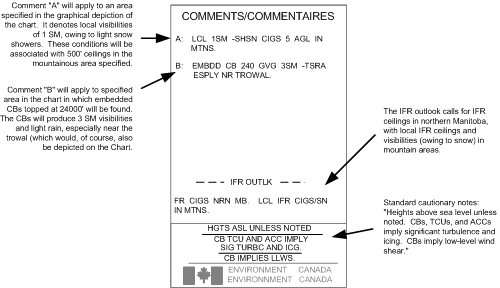
The comments box provides information that the weather forecaster considers important for the reader—e.g., the formation or dissipation of fog, increasing or decreasing visibility, etc. As well, standard phrases—typically of a cautionary nature— will appear in this box—“HGTS ASL UNLESS NOTED” and “TCU, ACC AND CB IMPLY SIG TURBC AND ICG. CB IMPLIES LLWS.” The most important feature of the comment box, however, are the “elaboration” that appears here—there are often weather systems that are so complex that those who draft the GFAs cannot fit all of the information into the little spaces that appear on the charts. Instead of trying to cram all of the written descriptions onto the map, they will simply assign a capital letter reference on the chart in the applicable location—the letter “A,” for example—and then provide the information under a matching letter “A” in the comment box. Finally with respect to the comment box, it is here where the “IFR Outlook” found on Twelve-hour Forecast GFAs will appear.
The “IFR outlook” portion provides an extended forecast view of conditions that can be expected 12-hours after the 12-hour GFA chart. The information here is very general in nature and simply indicates those areas where IFR weather is expected, the cause of the IFR weather, and any additional weather hazards that may be associated. There are three meaningful expressions that may be used here—IFR, Marginal VFR (MVFR), and VFR—and it is important to know the criteria associated with these expressions:
|
IFR |
Instrument Flight Rules—Ceilings less than 1000’ AGL, or visibility less than three (3) miles. |
|---|---|
|
MVFR |
Marginal Visual Flight Rules—Ceilings between 1000’ and 3000’ AGL, or visibility between three (3) and five (5) miles. |
|
VFR |
Visual Flight Rules—Greater than 3000’ AGL ceilings and greater than five (5) miles visibility. |
GFA Abbreviations
The following is a list of the codes that can appear in the GFA Comment Boxes (please note that the codes change over time and the current listings, published in the AIM, should be consulted):
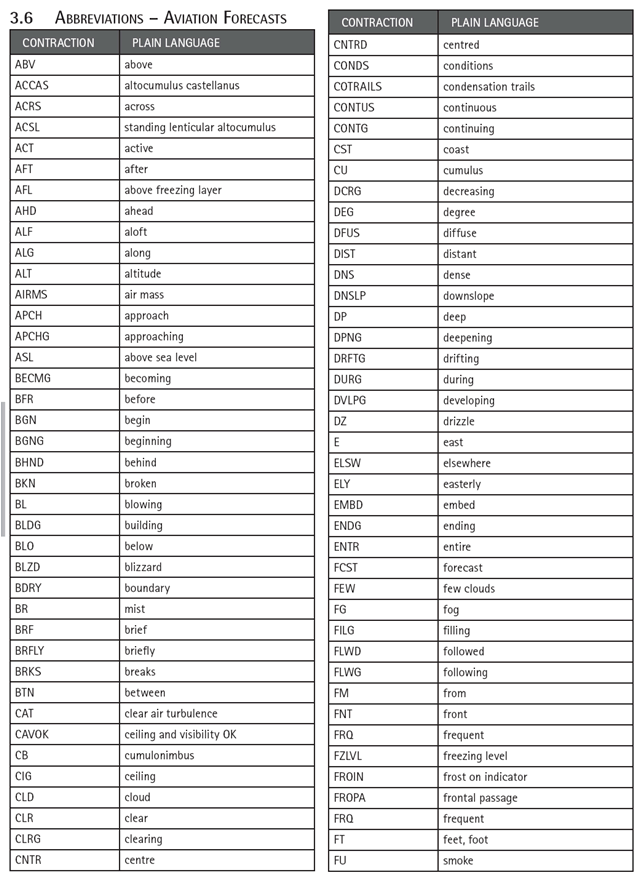
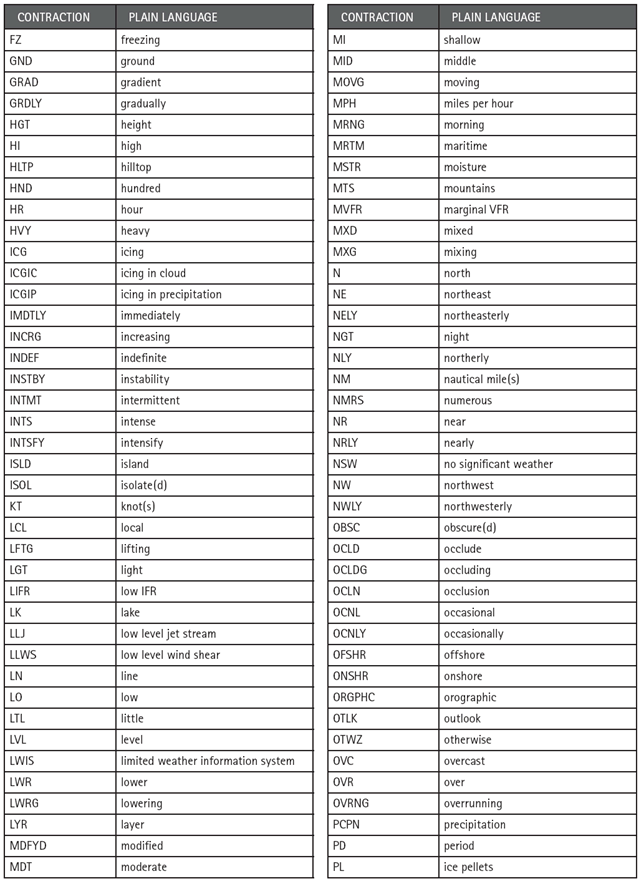
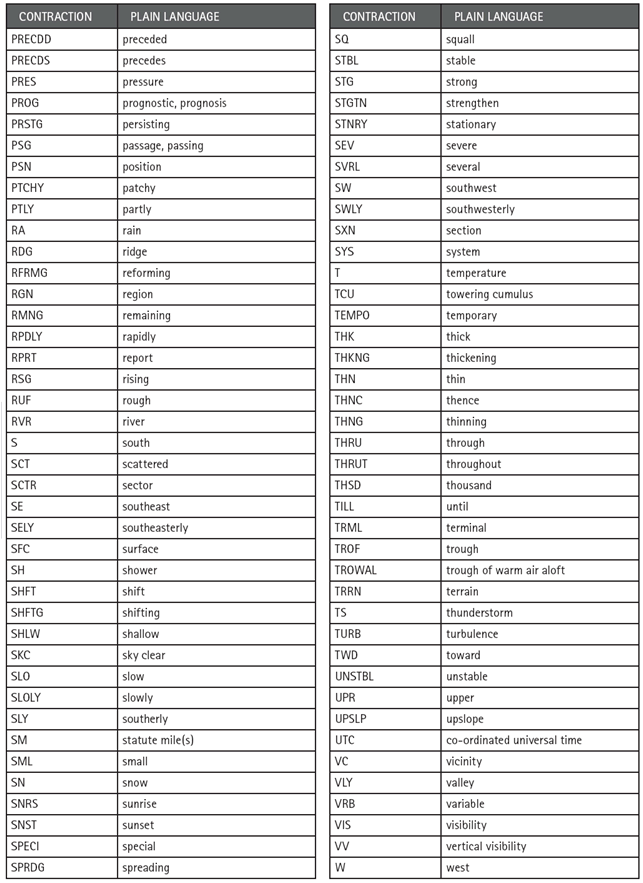
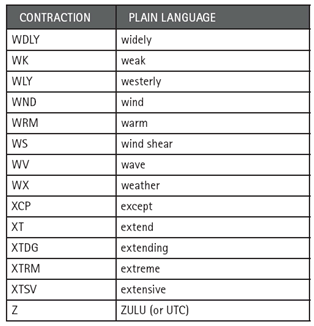
1 It is important to understand here that the GFAs provide what is essentially a “snap-shot” of the weather as it is positioned at the valid time indicated on each chart, but weather systems, of course, are always in a state of change—they are “dynamic.” As you will see the “snap-shot” also includes the crucial direction and speed of the system feature—a cold front, for example. If you want to know the position of the cold front and its associated weather three hours after the validity time, what most do is pencil in on the chart the advanced position in accordance the direction and speed indicated—a cold front travelling eastward at 20 knots will, after the passage of three hours, be 60 miles further east. For Commercial Pilot students, it is this ability to plot a dynamic weather system that is tested on the Transport Canada written examination.
GFA Weather Information—CLDS & WX GFA
The Weather Information portion of a GFA has two formats, one that is applicable to the Clouds and Weather (CLDS & WX), and the other applicable to the Icing, Turbulence and Freezing Level (ICG/TURBC/FRLVL). This section first examines the Clouds and Weather (CLDS & WX) GFA.
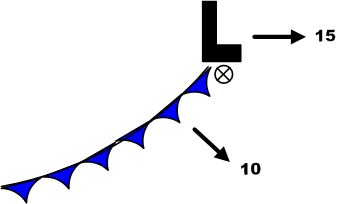
The CLDS & WX GFA provides a forecast of cloud layers and/or surface-based phenomena, visibility, weather and obstruction to vision that are expected at the valid time of individual charts. On the charts are found isobar lines that join areas of equal pressure, and also found are graphic depiction of any significant weather systems—referred to as synoptic features—that affect the weather. Typically, the synoptic feature will consist of the prevailing pressure patterns and the associated frontal systems. In the depiction above, for example, we are shown a low pressure centre with its location represented by the “x” in a circle. The low pressure is shown to move easterly at 15 KTS, while the associated cold front (“icicles on a string”) is shown to move south-easterly at 10 KTS. If the speed of the system is less than 5 knots, the letters “QS” will appear.
Clearly, the ability to decipher the symbols used in weather charts is important, and while the symbols may initially appear to you as Greek, they will with experience become rather straightforward. Here, then, are the symbols and meanings that can be expected on a GFA:
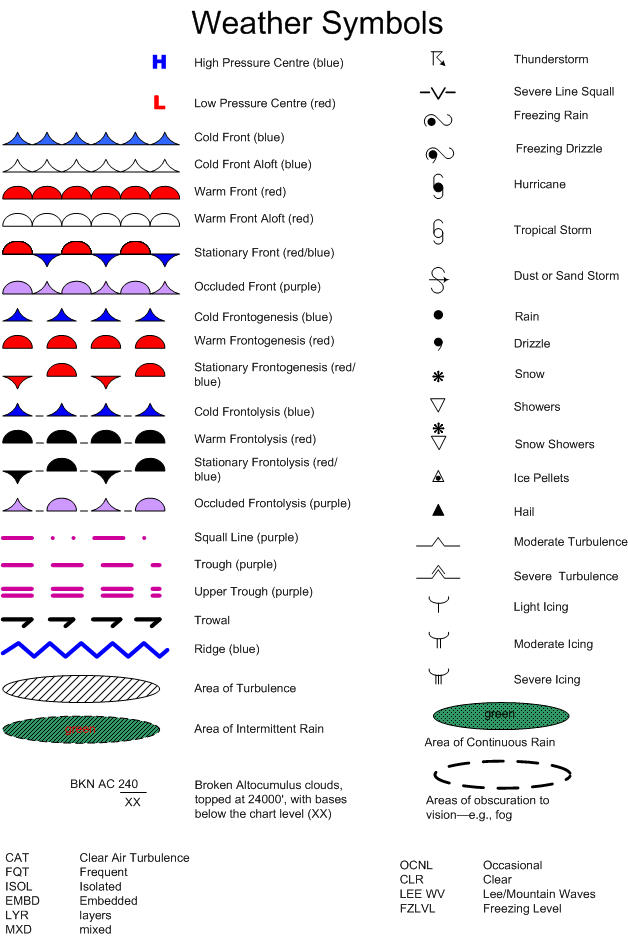
Clouds
The depiction of clouds on a CLDS & WX GFA represents the bases and tops of clouds that are expected between the surface and FL240 (24000’ ASL).
If the clouds are convective in nature—i.e., clouds that are formed as a result of being heated through contact with the earth’s surface, producing rising columns (TCU, ACC or CB)—then the tops of these will be indicated even if they extend over FL240.1
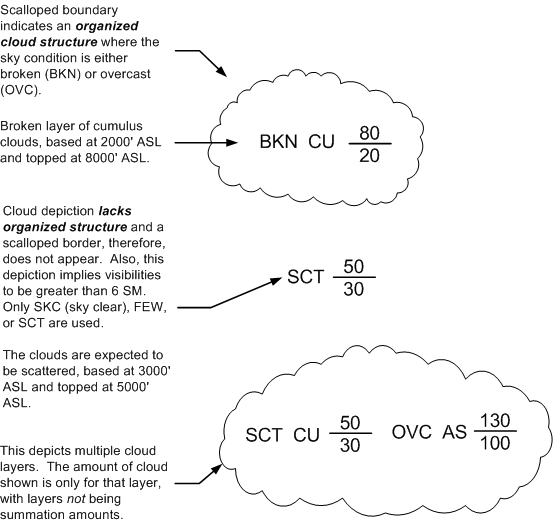
Generally, the cloud type will be shown on a GFA if this is considered to be significant.
Note that if the cloud structure is organized,2 the cloud depicted will be surrounded by a scalloped border indicating the general position of the structure.
Where clouds are expected, but the clouds lack any organization, then the scalloped border will not appear. Importantly, however, the scalloped border will appear where, even though cloud structure is lacking, the visibility is expected to be 6 SM or less.
Note that in the case of multiple-layered clouds, the amount of cloud—e.g., FEW, SCT or BKN—is not cumulative (as is the case with METARS, for example).
Generally, all heights are indicated in hundreds of feet ASL. Where heights are indicated above ground (AGL), then the abbreviation CIG is used—for example, the expression “XTNSV ST CIGS 3-10 AGL” is translated that there are extensive stratus ceilings 300’ to 1000’ AGL.
The term “LYRS” indicates that random clouds exist in a layer less than 1000’ thick, but does not constitute a solid cloud mass.
References
1 The higher the tops, the greater the severity of the weather produced by convective clouds.
2 “Organized,” means forming a distinct pattern.
Visibility
Visibilities are always reported in statute miles, and when visibilities are expected to be greater than 6 SM, the code P6SM is used. If the visibilities are forecast to be 6 SM or less, the obstruction limiting the visibilities is described—e.g., 4SM –SHRA. The codes used here will be standardized in accordance with those that appear in METARs.
Areas where precipitation is forecast will be enclosed, in the case of intermittent or showery precipitation, by dashed lines, and in the case of continuous precipitation, by solid lines.
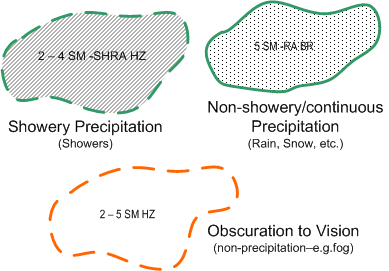
For convective clouds and showers, the following additional abbreviations are used to denote density:
|
Abbreviation |
Description |
Special Coverage |
|---|---|---|
|
ISOLD |
Isolated |
Less than 25% |
|
SCT |
Scattered |
25-50% |
|
NMRS |
Numerous |
Greater than 40% |
For non-convective clouds and precipitation, low ceilings, precipitation ceilings, icing, turbulence, or restrictions to visibilities, the following additional abbreviations are used to denote density:
|
Abbreviation |
Description |
Special Coverage |
|---|---|---|
|
LCL |
Local |
Less than 25% |
|
PTCHY |
Patchy |
25-50% |
|
XTNSV |
Extensive |
Greater than 40% |
Winds and Pressure

Surface winds are placed on the GFA where the speeds are at least 20 KTS, and are indicated graphically by the wind barb and the associated speed values. A wind barb should be interpreted to show wind direction like an arrow, with the “tail feathers” indicating speed. A long tail feather represents a 10-KT value, while a short tail feather indicates a 5-KT value. The appearance of a triangle on the barb indicates 50 KTS. The depiction above represents a westerly wind with gusts to 35 KTS. Also seen on the CLDS & WX GFA are isobars, which are set at 4-millibar intervals.
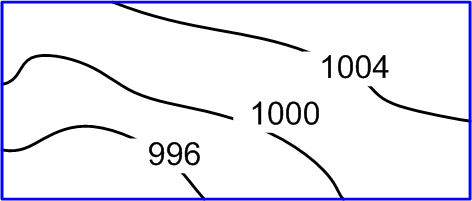
Here is an example of a CLDS & WX GFA layout:
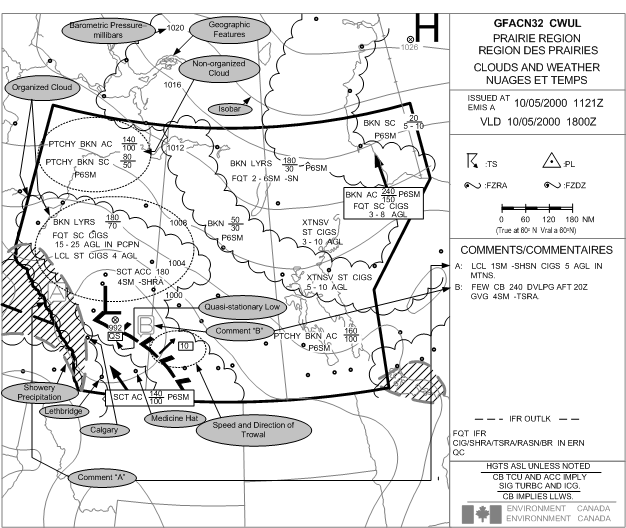
The centre of the low pressure is located about 60 NM to the east-south-east of Red Deer, and associated with this is a trowal that extends from 30 miles south of Red Deer to beyond the U.S. border just south of Swift Current, Saskatchewan. We can see that the low pressure is quasi-stationary, but that the trowal associated with it is migrating to the northeast at a speed of 10 KTS. The weather associated with the low pressure and trowal is surrounded by a scalloped border that extends up into central Alberta (circled with superimposed dashed lines), and indicates broken cloud layers based at 7000’ ASL, topped at 18000’ ASL, with frequent scattered ceilings based at 1500’ to 2500’ AGL, and that these lower ceilings are associated with precipitation. We are also advised that local stratus ceilings exit in this general area, and that these are as low as 400’ AGL. Also, we can expect scattered altocumulus castellanus clouds topped at 18000’ that will produce 4 SM visibility in light rain showers. In contrast, behind the trowal—in the triangle extending east from Lethbridge to include Medicine Hat—we can expect scattered altocumulus clouds; they will be based at 10000’ ASL, and topped at 14000’ ASL, giving visibilities greater than 6 SM. Comment “B” also specifies that the system will likely produce a few cumulonimbus clouds with tops as high as 24000’ ASL, but that these will likely not appear until after 2000Z; when they do appear, they will be associated with visibilities of 4 SM owing to light rain from thunderstorms. Finally, Comment “A” warns of locally low visibilities—as low as 1 SM—and ceiling—500’ AGL—in mountainous areas owing to snow showers.
Dynamic Systems
It is important to remember that the systems on the GFA are in fact continually in motion, moving in accordance with the speed and direction information provided on this chart. In the above chart, for example, the low centre is stationary, but the trowel is migrating to the northeast at a speed of 10 KTS. And, importantly, not only is the trowel migrating, but so is the weather associated with it.1 If, for example, we are interested in the position of the weather 6 hours after the issue of the above chart, we can anticipate the position of the trowel to be some 60 NM to the north-east of its current position; similarly, the associated weather depicted ahead of the trowel, as well as the weather behind the trowel, will also move about 60 NM to the north-east. Make use of the Scale always drawn on the chart. Below is a depiction of the advanced trowel—6 hours after the issue of the original GFA. Note the evolving position of the two cloud mass boundaries:
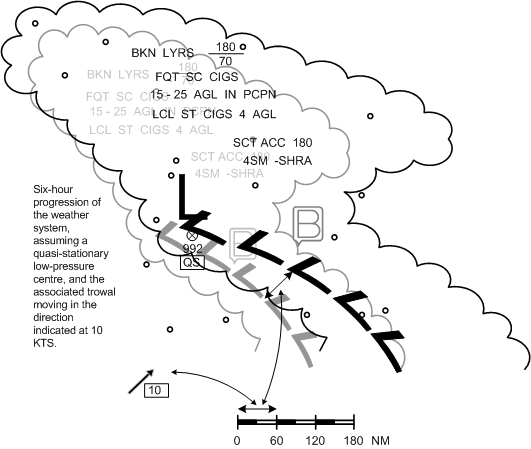
1 The exception to this, of course, would be the weather associated with mountainous areas (mountain waves, for example).
Weather Information— ICG/TURBC/FRLVL
The ICG/TURBC/FRLVL GFA provides a forecast of areas of icing and turbulence, as well as the expected height of the freezing level at the specified time of the chart. Included in the depiction are the type, intensity, bases and tops of the expected icing and turbulence areas. The surface synoptic features that appear on the CLDS & WX GFAs also appear on the ICG/TURBC/FRLVL GFA.
Icing
Forecast areas of icing will only appear whenever moderate or severe icing is anticipated. The vertical feature of the icing conditions will be presented in a format identical to that with cloud. Note that areas of light icing will not be specified graphically on the chart, but instead will appear in the Comments Box. The following example depicts an area of moderate mixed icing, based at 2000’ ASL, topped at 13000’ ASL:
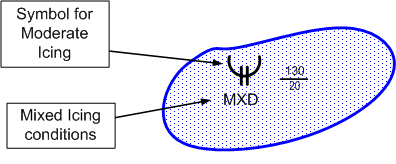
Should the icing conditions be expected during only a part of the forecast period for which the GFA is published, the time of occurrence of the icing will be indicated in the Comments Box.
Turbulence
Areas of turbulence will be depicted on the GFA whenever forecast to be moderate or severe in magnitude. In the event that the turbulence is the result of mechanical turbulence, low-level wind shear, mountain wave activity, or clear air turbulence, an abbreviation will appear indicating the cause. The depiction below shows moderate clear air turbulence between 8000’ASL and 20000’ ASL.
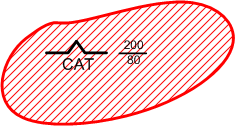
The following interpretations with respect to the level and definition of turbulence are applied:
|
Light |
Turbulence that momentarily causes slight, erratic changes in altitude and/or attitude; occupants will feel a slight strain on seat belts and unsecured objects may be slightly displaced. |
|---|---|
|
Moderate |
Changes in altitude and/or attitude occur but aircraft remains in positive control, and airspeed will vary; occupants feel definite strain against seat belts and unsecured objects are dislodged. |
|
Severe |
Turbulence causes large, abrupt change in altitude and/or attitude and aircraft may become momentarily out of control; occupants are forced violently against seat belts and unsecured objects are tossed about. |
|
Extreme |
Aircraft is violently tossed about and is impossible to control; structural damage may occur. |
Freezing Level Isotherms
The freezing level isotherms are indicated on the GFA as dashed lines. The height of the freezing levels is indicated as heights ASL, and is depicted in 2500’ intervals.
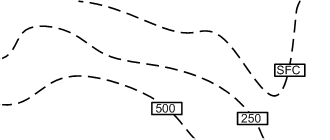
Note that the air mass depicted here is therefore warmer as you proceed south—the freezing level rises.
Special modifications of the freezing level—associated with, for example, warm air aloft—will be explained in the Comments Box.
Below is a sample ICG/TURBC/FRLVL GFA. Note that the freezing level is at the surface in the upper right-hand area of the chart, and rises to 7500’ in southern Saskatchewan and Manitoba. The area of icing depicted in north-central Manitoba shows moderate rime icing, based at the freezing level (which is on the surface in the northern portions of the chart), and topped at 12000’. This area of icing may or may not move to the Northeast in conjunction with the movement of the trowel. We also note the area of moderate turbulence along the central Alberta-Saskatchewan border. The vertical dimensions are defined as extending from the surface to 3000’ AGL and the cause is mechanical disturbance of the airflow by the surface; because of the proximity of this area of turbulence to the low pressure—likely the cause—it will probably remain stationary and build or dissipate with the low pressure. Finally, note the standard cautions that appear in the lower portion of the Comment Box—all heights are above sea level unless otherwise advised, reference to CBs, TCUs, or ACCs imply significant turbulence and icing, and with reference to CBs also implies low-level wind shear.
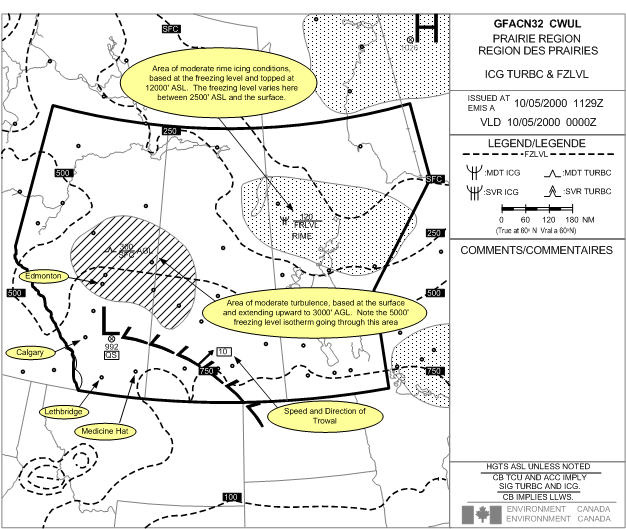
GFA Amendments and Corrections
GFAs are automatically amended by AIRMETs whenever conditions considered significant for aircraft have not been forecasted and do not, therefore, appear in the GFAs. The AIRMET will specify the GFA amended. Also, GFAs are automatically amended by SIGMETs, even though this will not be explicitly stated.
A GFA, in turn, will be re-issued where one or more of the original GFA charts contain a significant error that could lead to misinterpretation. Such corrective GFAs will indicate the by the code “CCA” which appears in the Title Box, with the “A” indicating the first correction—should a “CCB” appear, the “B” will indicate that the GFA issue is the second correction, etc.
Runway Visual Range
Runway Visual Range (RVR) is provided to IFR pilots as an indication of how far the they expect to see along the runway in the touchdown zone.1
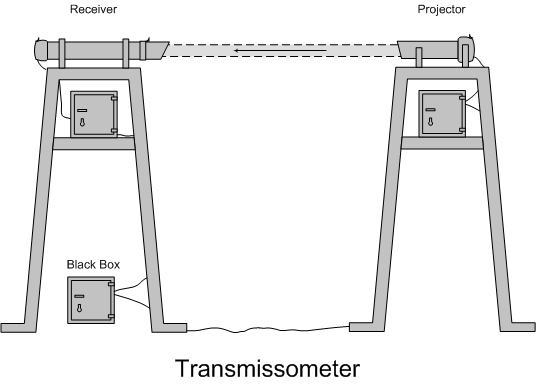
RVR values are provided by a transmissometer that is permanently located adjacent to the runway surface. The transmissometer consists of a projector and receiver that continually measures the opacity of the air between the two units; this information, in turn, is relayed to ATS—the IFR controller responsible for arrivals, the tower controller, and/or FSS personnel. The RVR black box automatically averages the readings during the preceding minute, and is especially useful for assessing large fluctuations that occur in visibility during short time intervals.
ATS will provide RVR values when less than 6000’, or when requested by the pilot. RVR values are also contained in METARS, but their presence there is only advisory in nature, and is not to be used for operational purposes. RVR is provided in 100’ increments when values are between 300’ and 1199’, and in 200’ increments when values are between 1200’ and 2999’, and in 500’ increments when values are 3000’ or above.
RVR represents an assessment of the pilot’s visibility during the landing and takeoff phase, and the measurement, in feet, factors in variations for daylight and the brightness of runway lighting. Accordingly, assuming the opacity of the air remains unchanged, RVR values will increase at night (when contrasting light is more discernable), and increase with an increase in the setting of the intensity or brightness of runway lighting. RVR values, which appear as a digital readout to ATS personnel, are automatically calculated using the average value variations over approximately one minute.
References
1 AIM, RAC 9.21.2.
Airborne Weather Radar
The primary function of airborne weather radar (AWR) is thunderstorm detection and avoidance. Operated during flight, AWR provides a cockpit display of significant weather that lies ahead of the flight path. Detection of thunderstorms is based on the detection of rainfall density, where, quite simply, the greater the rainfall density detected, the more severe the weather.
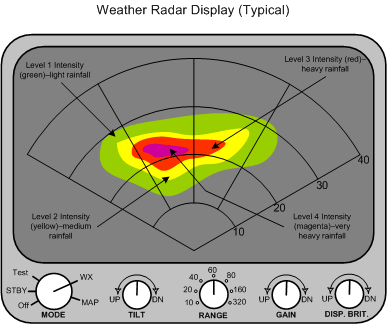
It is important to know limitations of AWR, and in particular the fact that it only detects liquid raindrops. It does not detect, for example, clouds or developing thunderstorms that lack liquid raindrops. While wet hail has high reflectivity, dry hail does not. Ice crystals provide only moderate reflectivity.


AWR works by transmitting a very narrow, and highly directional, coned-shaped radar beam ahead of the aircraft’s flight path. The radar projector, referred to as the antenna, is motorized, enabling the antenna to continuously sweep ahead of the aircraft’s flight path. It is typically located in the nosecone of the aircraft, behind a radome that is composed of non-reflective material. Incorporated in the cockpit equipment is a tilt feature, either automatic or manual, which enables the crew to raise or lower the sweep above and below the longitudinal axis of the aircraft. When assessing the intensity of a thunderstorm, the tilt should be adjusted to the middle and lower portions of the system where the density of precipitation provides the most accurate indications of size and intensity.
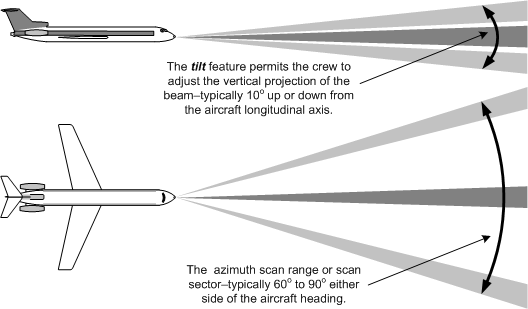
Cockpit equipment is conventional in most aircraft, including range settings, a weather and ground mapping modes, tilt, and gain. The ground mapping feature is used for terrain surveillance, while the gain adjusts the sensitivity of the receiver so as to exclude the display light precipitation and better define heavy rainfall.
The rates of rainfall are graded by the computer connected to the AWR, and display in accordance with levels—typically three to four levels. The levels are in turn displayed on an azimuth using color coding.
There are two ways to interpret the imaging that appears on a AWR cockpit display—the height of echo returns, and the shape of echo returns. By adjusting the tilt of the radar beam, the display will provide a mapping of the upper layers of thunderstorms. Generally, the higher the echoes, the more severe the weather. In contrast, contour provides information on the gradient of rainfall, the idea being that steep gradient represents severe weather. Reading the gradients presented on the display, there are telltale shapes that should be avoided, as indicated below:
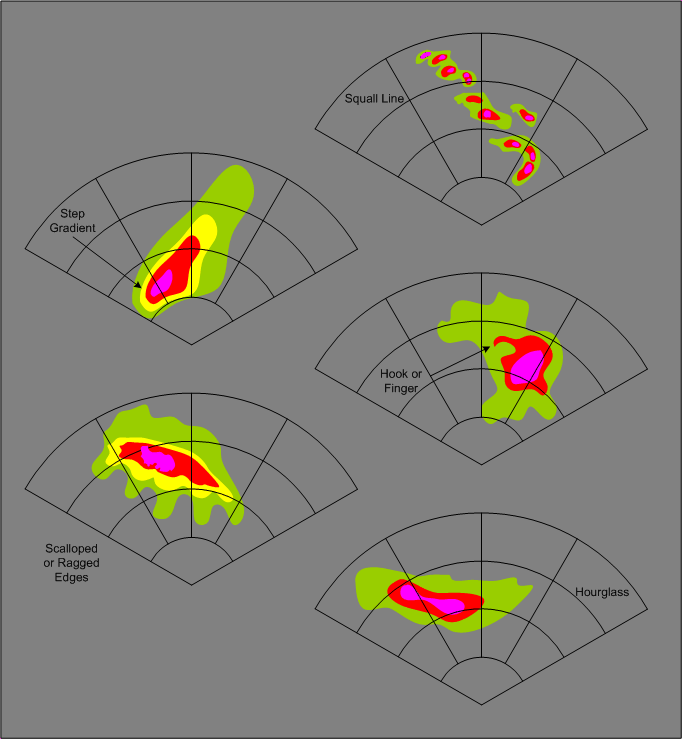
One of the primary limitations to AWR systems is attenuation. Attenuation, in this case, means to lessen in force or strength, and refers to the tendency of heavy rainfall areas to block the radar beam from projecting into areas that lie beyond. The affect of attenuation is to produce what are referred to as radar shadow—areas of severe attenuation in which there is a blackout of all data related to areas behind heavy rainfall. These areas might first appear to provide no radar return and thus no indication of precipitation, when in fact there is no information pertaining to what lies there. The rule of thumb, therefore, is not to fly “around corners” into clear areas which lie beyond heavy precipitation gradient.
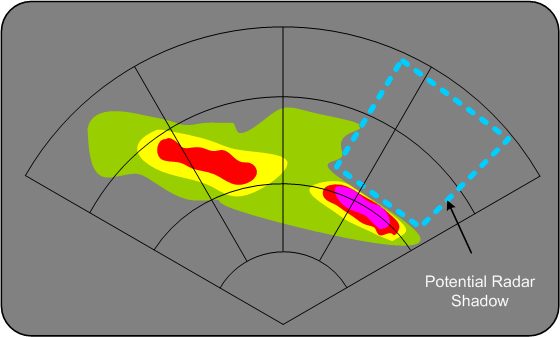
Lightning Detectors
The primary function of lightning detectors (LDs)—sometimes referred to as electrical discharge detectors and stormscope (named after a popular brand)—is also thunderstorm detection and avoidance. Rather than using rainfall density as a means of mapping severe weather, LDs use a radio receiver to sense electrical discharge. The discharge readings are processed though a computer, and location (including bearing and range) is displayed on a screen.
LD displays plot each “stroke” or discharge of lightning over a period of time, so the pilot is presented with a depiction of intensity based on the rate at which stroke indications accumulate on the display. With early LDs, the display is fixed independent of the aircraft heading, so a change in aircraft heading invalidates the plot; in contrast, later LDs utilize gyros to synchronize the plotting on the display with changes in aircraft heading.
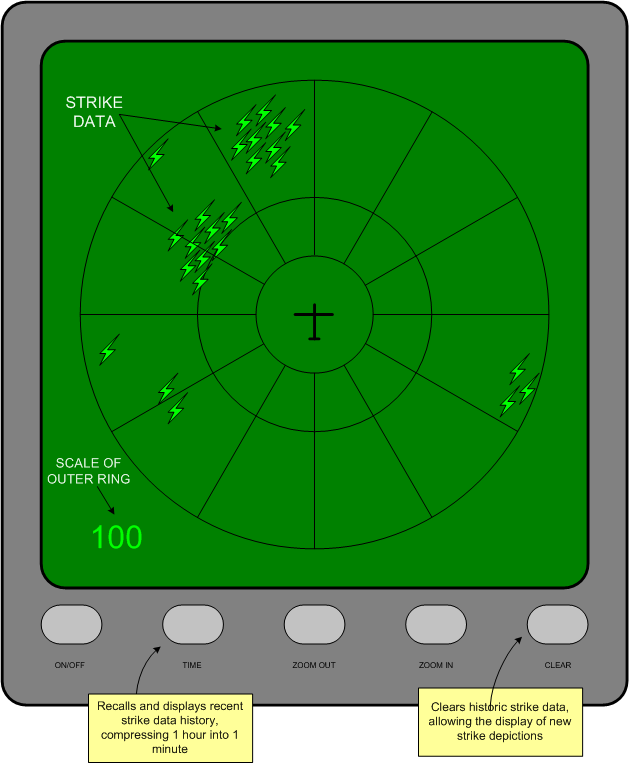
LDs are effective in displaying the correct bearing to lightning strikes, but are less accurate in depicting the range of a strike. As a rule, unusually strong lightning strikes are displayed closer than they actually are, while the reverse is the case with weak strikes. Owing to this error, areas displaying electrical discharge must be avoided with a wider margin of distance, unless the storm source is backed up with visual or weather radar data. On the positive side, LDs are not subject to attenuation shadows, and, also unlike AWR systems, provide a 360° view of thunderstorm activity. While AWR systems cannot be operated on the ground prior to takeoff, LDs can.
.jpg)
